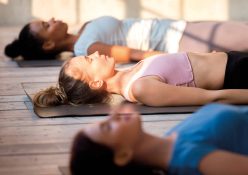Be proactive about your health with these vital self-examinations. By Erin Coe and Tracy Branfield
 Regular self-exams can be some of the best early-warning systems for serious health conditions – plus they’re free and can be performed at your convenience and in the comfort of your own home. Put your health in your hands and start performing the following at regular intervals throughout the year.
Regular self-exams can be some of the best early-warning systems for serious health conditions – plus they’re free and can be performed at your convenience and in the comfort of your own home. Put your health in your hands and start performing the following at regular intervals throughout the year.
Eye test
According to optometrist Jacqui Bauer, we should all have an eye exam every two years. ‘And since eyesight tends to deteriorate with age, people who are older than
50 should have eye exams yearly.’ One of the most devastating eye diseases is macular degeneration, which the World Health Organization says accounts for 7.1% of global blindness. Jacqui explains, ‘It is a degenerative disease that affects certain layers of the retina.’
Most cases occur after the age of 60 and are thus termed age-related macular degeneration, or AMD. In certain cases, AMD can advance so slowly that sufferers don’t even notice the changes in their vision. In other cases, it can progress very quickly and lead to the loss of vision in both eyes. There are two kinds of AMD: dry and wet. ‘The wet one is more serious, and it can destroy vision,’ says Jacqui. Luckily, wet is less common, despite its more aggressive nature. Sadly, there is no treatment for either, but wet AMD may be stalled with laser surgery or injections into the eye.
Do it yourself Close one eye at a time and look at an object about 35 cm away from you. If there’s a blurry spot in the centre, you should speak to your optometrist as soon as possible.
Breast check
‘The most important things you can do for breast health is make better lifestyle choices and be aware of how your breasts usually look and feel. Nonetheless, doing monthly breast self-exams can be beneficial for picking up any existing problems,’ explains Dr Elizabeth Murray, a Cape Town-based oncologist .
‘Keep an eye out for dimpling, any lumps, discharge, inflammation and redness, a new inversion of the nipple, swollen glands under your arm or in your neck and an eczema–
like texture of the nipples,’ explains Dr Murray. ‘Cancers can mimic some infections like eczema, so be sure to see a doctor if one is unresolved.’
Opt for a clinical breast exam (CBE) every one to three years if you are between the ages of 20 and 40. If you are over 40, have a CBE done every year. During a CBE, a health professional will examine your breasts and may send you for a mammogram (an X-ray of your breasts) to investigate any suspicious lumps. ‘If you’ve had problems with your breasts before, or have a history of breast cancer in your family, you may be advised to consult with an expert, such as a specialist surgeon,’ suggests Dr Murray.
Do it yourself Breasts are typically more lumpy before a period, so it is best to check them afterwards. Standing in front of a mirror, raise your arms and look straight on and from the sides to check for any kind of asymmetry. Lie on your back and inspect the whole breast, including under the nipple and armpit, gently pressing the pads of your fingers into your breast tissue.
Testicle check
According to the Head of Health at Cansa, Professor Michael Herbst, testicular self-examinations should be done monthly and you should start around the age of 14. ‘By then, the testicles are developed enough to check. It is also unusual for boys younger than 15 to have testicular cancer.’ Because testicular tumours usually grow rapidly, early detection and treatment is important.
Do it yourself After a warm bath or shower, stand in front of the mirror and look for any signs of swelling in the area. Cup your testicles with one hand and gently roll each one between the thumb and fingers of the other hand, feeling around for any lumps or tender spots. You will feel a soft, rope-like structure, the epididymis, on the top and back of each testicle. This is completely normal and isn’t cause for concern.
Skin examination
‘Everyone ought to do a monthly body self-exam to identify the early signs of melanoma, a kind of skin cancer,’ says Cape dermatologist Dr Suretha Kannenberg. This exam involves carefully inspecting your entire body for existing moles and any changes in their appearance (see box to find out what you’re looking for). ‘Generally one does not develop new moles after the age of 40; if you notice new ones forming thereafter, this should raise concern. And if you have a blood relative, especially a first-degree relative, with a history of melanoma, you should also see a dermatologist for a check-up once a year,’ advises Dr Kannenberg.
Do it yourself Disrobe and stand in front of a full-length mirror. Examine your face, ears and neck. Use your hairdryer to expose your scalp and check along your hairline. Move on to your shoulders, arms, hands and even fingernails. Check your chest, abdomen, back, buttocks and the backs of your legs. Take a seat and examine the front of your legs, the tops and the soles of your feet and your toenails. Finish by checking the genital area with a hand mirror.
Use the ABCDE criteria as a guideline for what to look out for:
Asymmetry One half of the mole does not match the other.
Border The border of the mole is irregular or blurred.
Colour The colour is not the same throughout the mole. Black, red, blue or white are colours that may indicate a problem.
Diameter A mole larger than six millimetres should be examined by a professional.
Evolution Watch out for constant bleeding, itching or irritation of the mole, as well as changes in the above criteria.







